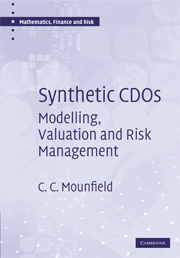Book contents
- Frontmatter
- Contents
- Preface
- Acknowledgements
- 1 A primer on collateralised debt obligations
- 2 Modelling of obligor default
- 3 Valuation of credit default swaps
- 4 Credit indices
- 5 Valuation of default baskets
- 6 Valuation of synthetic CDOs
- 7 Phenomenology of the standard market model
- 8 Risk quantification of synthetic CDOs
- 9 Implied and base correlations
- 10 Extensions of the standard market model
- 11 Exotic CDOs
- 12 Correlation trading of synthetic CDO tranches
- 13 Risk management of a portfolio of synthetic CDOs
- 14 Hedging simulation of structured credit products
- Appendix A Explanation of common notation
- Appendix B Simulated annealing
- References
- Index
9 - Implied and base correlations
Published online by Cambridge University Press: 06 July 2010
- Frontmatter
- Contents
- Preface
- Acknowledgements
- 1 A primer on collateralised debt obligations
- 2 Modelling of obligor default
- 3 Valuation of credit default swaps
- 4 Credit indices
- 5 Valuation of default baskets
- 6 Valuation of synthetic CDOs
- 7 Phenomenology of the standard market model
- 8 Risk quantification of synthetic CDOs
- 9 Implied and base correlations
- 10 Extensions of the standard market model
- 11 Exotic CDOs
- 12 Correlation trading of synthetic CDO tranches
- 13 Risk management of a portfolio of synthetic CDOs
- 14 Hedging simulation of structured credit products
- Appendix A Explanation of common notation
- Appendix B Simulated annealing
- References
- Index
Summary
Introduction
In previous chapters we have introduced and analysed the standard market model for valuing synthetic CDOs. In this and the next chapter we examine the natural consequences of what happens when a bespoke, illiquid market becomes standardised and highly liquid. Specifically with the introduction of standardised CDS indices and documentation specifying the terms and conditions of credit derivative contracts, the trading of credit exposure ramped up enormously. The subsequent introduction of exposure to tranched portions of these standardised portfolios also proved to be immensely popular with investors. At some point the nature of the market changed and it became possible to observe quoted prices for the standardised indices and tranches provided by the brokers and market makers.
Once a market becomes sufficiently liquid to allow efficient price discovery for ‘vanilla’ instruments, the rationale for a model changes. In an illiquid market where there is no price guidance a model is the only means for determining an instrument's value. In a liquid market, however, the market observed prices must act as a target that a model is calibrated to. If a model does not accurately reproduce the market observed prices of vanilla instruments then there is a real danger someone using the model to price instruments will be arbitraged. The model, once calibrated, can then be used to provide price guidance for bespoke tranches.
- Type
- Chapter
- Information
- Synthetic CDOsModelling, Valuation and Risk Management, pp. 190 - 203Publisher: Cambridge University PressPrint publication year: 2008



